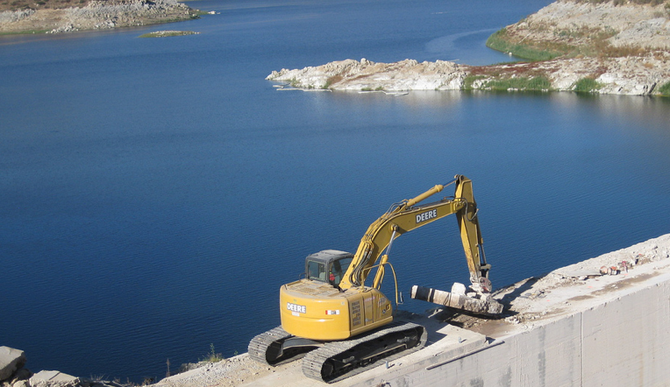 Facebook
Facebook
 X
X
 Instagram
Instagram
 TikTok
TikTok
 Youtube
Youtube

As the world gradually shifts its energy focus to renewable sources such as solar and wind, utilities are faced with a demand for secondary sources — those that are available when the sun isn't shining or the wind doesn't blow.
One option is so-called "peaker plants," traditional power plants fired by natural gas that operate only during periods of peak demand. Like other gas plants, efforts to install them have drawn heavy criticism from nearby residents and the environmentally minded in general. Another strategy being pursued by San Diego Gas & Electric is the installation of energy storage facilities, essentially massive battery banks that load up during the day when renewables are pumping more power into the grid than is needed and depleting during peak demand times in the evening.
The San Diego County Water Authority is floating a similar idea, using water from the San Vicente Reservoir near Lakeside as an alternative means of storage to lithium ion cells. Partnering with the City of San Diego (which owns the reservoir), the water authority has received a preliminary permit for the project, which will allow the partnership to solicit parties that would be interested in the power were it to be built.
A dam-raising project completed in 2014 created the potential for the water authority's so-called San Vicente Energy Storage Facility. It would consist of a second reservoir in the hills above San Vicente and an underground pump house with four 125-megawatt reversible pump-turbines. During times of excess power supply, the devices would pump water from San Vicente into the secondary reservoir, where the water would essentially serve the same function as a battery. When the grid needed to tap into power, water would be released, generating up to 500 megawatts of power as it passes through the turbines — roughly enough to power 325,000 homes for eight hours.
Per the authority, the project would have no adverse effect on water quality, fisheries, or other recreational uses of the lake. After soliciting for interest from utilities, developers, and others interested in partnering on the project, the group expects to report back sometime in April, though actual construction could be as much as a decade from completion.


As the world gradually shifts its energy focus to renewable sources such as solar and wind, utilities are faced with a demand for secondary sources — those that are available when the sun isn't shining or the wind doesn't blow.
One option is so-called "peaker plants," traditional power plants fired by natural gas that operate only during periods of peak demand. Like other gas plants, efforts to install them have drawn heavy criticism from nearby residents and the environmentally minded in general. Another strategy being pursued by San Diego Gas & Electric is the installation of energy storage facilities, essentially massive battery banks that load up during the day when renewables are pumping more power into the grid than is needed and depleting during peak demand times in the evening.
The San Diego County Water Authority is floating a similar idea, using water from the San Vicente Reservoir near Lakeside as an alternative means of storage to lithium ion cells. Partnering with the City of San Diego (which owns the reservoir), the water authority has received a preliminary permit for the project, which will allow the partnership to solicit parties that would be interested in the power were it to be built.
A dam-raising project completed in 2014 created the potential for the water authority's so-called San Vicente Energy Storage Facility. It would consist of a second reservoir in the hills above San Vicente and an underground pump house with four 125-megawatt reversible pump-turbines. During times of excess power supply, the devices would pump water from San Vicente into the secondary reservoir, where the water would essentially serve the same function as a battery. When the grid needed to tap into power, water would be released, generating up to 500 megawatts of power as it passes through the turbines — roughly enough to power 325,000 homes for eight hours.
Per the authority, the project would have no adverse effect on water quality, fisheries, or other recreational uses of the lake. After soliciting for interest from utilities, developers, and others interested in partnering on the project, the group expects to report back sometime in April, though actual construction could be as much as a decade from completion.
Comments